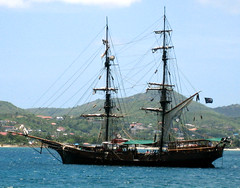The Transatlantic Triangular Trade operated during the 17th, 18th and early 19th centuries, carrying slaves, cash crops, and manufactured goods between West Africa, the Caribbean or American colonies and the European colonial powers, with the northern colonies of British North America, especially New England, sometimes taking over the role of Europe.[1] Thus reports Wikipedia.
The use of African slaves was fundamental to growing colonial cash crops, which were exported to Europe. European goods, in turn, were used to purchase African slaves, which were then brought on the sea lane west from Africa to the Americas, the so called middle passage. [2]
A classic example would be the trade of sugar (often in its liquid form, molasses) from the Caribbean to Europe or New England, where it was distilled into rum, some of which was then used to purchase new slaves in West Africa.
Diagram illustrating the stowage of African slaves on a British slave ship.
The trade represented a profitable enterprise for merchants and investors. The business was risky, competitive and severe, but enslaved Africans fetched a high price at auctions, making the trade in human cargo a lucrative business[citation needed].
The first leg of the triangle was from a European port to Africa, in which ships carried supplies for sale and trade, such as copper, cloth, trinkets,slave beads, guns and ammunition. [3] When the slave ship arrived, its cargo would be sold or bartered for slaves, who were tightly packed like any other cargo to maximize profits.
On the second leg, ships made the journey of the Middle Passage from Africa to the New World. Once the slave ship reached the New World, enslaved survivors were sold in the Caribbean or the Americas.
The ships were then prepared to get them thoroughly cleaned, drained, and loaded with export goods for a return voyage, the third leg, to their home port.[4] From the West Indies the main export cargoes were sugar, rum, and molasses; from Virginia, commodities were tobacco and hemp. The ship then returned to Europe to complete the triangle.
Subscribe to:
Post Comments (Atom)


No comments:
Post a Comment